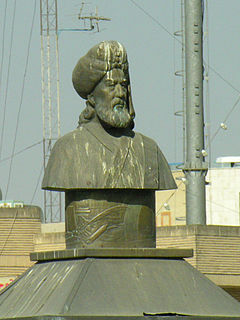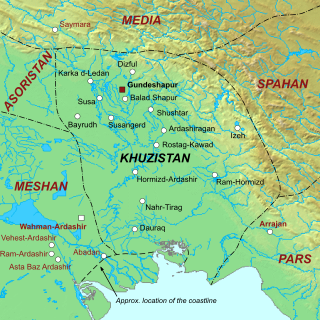
Khosrow I, traditionally known by his epithet of Anushirvan, was the Sasanian King of Kings of Iran from 531 to 579. He was the son and successor of Kavad I.

Kavad I was the Sasanian King of Kings of Iran from 488 to 531, with a two or three-year interruption. A son of Peroz I, he was crowned by the nobles to replace his deposed and unpopular uncle Balash.

Khosrow II, also known as Khosrow Parviz, is considered to be the last great Sasanian king (shah) of Iran, ruling from 590 to 628, with an interruption of one year.

Hormizd-Ardashir, better known by his dynastic name of Hormizd I, was the third Sasanian King of Kings (shahanshah) of Iran, who ruled from May 270 to June 271. He was the third-born son of Shapur I, under whom he was governor-king of Armenia, and also took part in his father's wars against the Roman Empire. Hormizd I's brief time as ruler of Iran was largely uneventful. He built the city of Hormizd-Ardashir, which still remains a major city today in Iran. He promoted the Zoroastrian priest Kartir to the rank of chief priest (mowbed) and gave the Manichaean prophet Mani permission to continue his preaching.

Hormizd IV was the Sasanian King of Kings of Iran from 579 to 590. He was the son and successor of Khosrow I and his mother was a Khazar princess.

Yazdegerd II, was the Sasanian King of Kings of Iran from 438 to 457. He was the successor and son of Bahram V.

Yazdegerd I, also spelled Yazdgerd I and Yazdgird I, was the Sasanian King of Kings of Iran from 399 to 420. A son of Shapur III, he succeeded his brother Bahram IV after the latter's assassination.

Bahram II was the fifth Sasanian King of Kings (shahanshah) of Iran, from 274 to 293. He was the son and successor of Bahram I. Bahram II, while still in his teens, ascended the throne with the aid of the powerful Zoroastrian priest Kartir, just like his father had done.

Ardashir III was the Sasanian King of Kings of Iran from 6 September 628 to 27 April 630.

Jamasp was Sasanian King of Kings of Iran from 496 to 498/9. He was a son of Peroz I and younger brother of Kavad I. Jamasp was installed on the Sasanian throne upon the deposition of the latter by the nobility and clergy.

Boran was Sasanian queen of Iran from 630 to 632, with an interruption of some months. She was the daughter of king Khosrow II and the Byzantine princess Maria. She is the second of only three women to rule in Iranian history, the others being Musa of Parthia, and Boran's sister Azarmidokht.

Bozorgmehr-e Bokhtagan, also known as Burzmihr, Dadmihr and Dadburzmihr, was an Iranian sage and dignitary from the Karen family, who served as minister of the Sasanian king (shah) Kavad I, and the latter son and successor Khosrow I. He also served as the military commander (spahbed) of Khwarasan under Khosrow I and his successor Hormizd IV. According to Persian and Arabic sources, Bozorgmehr was a man of "exceptional wisdom and sage counsels" and later became a characterisation of the expression. His name appears in several important works in Persian literature, most notably in the Shahnameh. The historian Arthur Christensen has suggested that Bozorgmehr was the same person as Borzuya, but historigraphical studies of post-Sasanian Persian literature, as well as linguistic analysis show otherwise. However, the word "Borzuya" can sometimes be considered a shortened form of Bozorgmehr.

The Sasanian or Sassanid Empire, officially known as the Empire of Iranians, and called the Neo-Persian Empire by historians, was the last Persian imperial dynasty before the Muslim conquest in the mid seventh century AD. Named after the House of Sasan, it endured for over four centuries, from 224 to 651 AD, making it the longest-lived Persian dynasty. The Sasanian Empire succeeded the Parthian Empire, and reestablished the Iranians as a superpower in late antiquity, alongside its neighbouring arch-rival, the Roman-Byzantine Empire.

Azarmidokht was Sasanian queen (banbishn) of Iran from 630 to 631. She was the daughter of king (shah) Khosrow II. She was the second Sasanian queen; her sister Boran ruled before and after her. Azarmidokht came to power in Iran after her cousin Shapur-i Shahrvaraz was deposed by the Parsig faction, led by Piruz Khosrow, who helped Azarmidokht ascend the throne. She was, however, the following year killed by Rostam Farrokhzad in retaliation for having his father killed. She was succeeded by Boran.
Šahrestānīhā ī Ērānšahr is a surviving Middle Persian text on geography, which was completed in the late eighth or early ninth centuries AD. The text gives a numbered list of the cities of Eranshahr and their history and importance for Persian history. The text itself has indication that it was also redacted at the time of Khosrow II in 7th century as it mentions several places in Africa and Persian Gulf conquered by the Sasanians.

Khosrow III was a Sasanian rival claimant who briefly ruled a part of Khorasan for a few months in 630.

Adurbadagan was a Sasanian province located in northern Iran, almost corresponded to the present-day Iranian Azerbaijan. Governed by a marzban ("margrave"), it functioned as an important frontier region against the neighbouring country of Armenia.

Sukhra was an Iranian nobleman from the House of Karen, who was the de facto ruler of the Sasanian Empire from 484 to 493. He was active during the reign of shah Peroz I, Balash and Kavad I. He is often confused with his father Zarmihr Hazarwuxt and son Zarmihr Karen.

Khuzistan or Huzistan was a Sasanian province in Late Antiquity, which almost corresponded to the present-day province of Khuzestan. Its capital was Gundeshapur. During the late Sasanian era, the province was included in the southern quadrant (kust) of Nemroz.


















